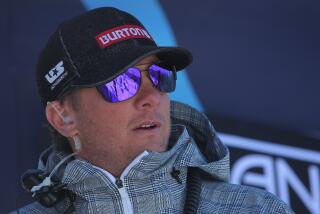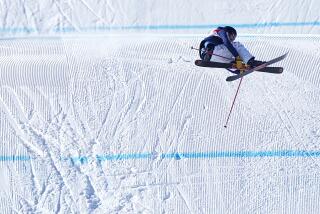A Ski Run for Border
SESTRIERE, Italy — American skiers Bode Miller and Erik Schlopy, set to compete in Alpine events at the Turin Olympics, crossed into Mexico to receive alternative therapy for knee injuries from a controversial physician who was barred from practicing in the United States.
Miller reportedly was treated within the last year; it was not clear when Schlopy sought treatment.
Miller, 28, and Schlopy, 33, as well as other athletes, visited the Ensenada clinic of Milne Ongley, a New Zealand-born orthopedist, to receive injections of what has been dubbed “the Ongley solution.”
Ongley’s website says the solution consists of dextrose, glycerin, phenol and distilled water. Phenol is a manufactured antiseptic sometimes used in mouthwash and throat lozenges, according to the Centers for Disease Control and Prevention. None of the ingredients is included on the U.S. Anti-Doping Agency’s banned list of substances, and neither skier has ever failed a drug test.
“We have no comment on it,” Melinda Roalstad, the U.S. Ski and Snowboard Assn.’s medical director, said Wednesday when asked about Ongley’s relationship with the skiers.
The treatments were first reported last week by ESPN the Magazine.
Miller, a two-time Olympic medalist, and Schlopy, the U.S. team’s oldest skier, have credited Ongley with helping them rebound from knee injuries.
Schlopy calls Ongley “the wonder doctor” and boasts on Ongley’s website of having “the youngest knees on the ski team.”
Some ski team officials are concerned because of the U.S. ban on Ongley and because the treatments are unregulated.
Men’s Alpine Coach Phil McNichol told ESPN the Magazine, “I’m assuming [Ongley is] in Mexico for a reason, other than a suntan.”
He added, “We’re really not comfortable with the guys doing it.”
McNichol said Wednesday that he was not backing off those comments but referred all questions about Ongley to the USSA medical staff.
“That’s not my field of play,” he said.
U.S. ski team spokesman Tom Kelly also declined to comment, adding that Miller had asked not to do any more print interviews. Schlopy was supposed to appear Wednesday with other U.S. skiers at an Alpine news conference in Turin, but that event was canceled.
Schlopy, a bronze-medal winner at the 2003 World Championships, will ski in the giant slalom here. Miller will compete in all five Alpine disciplines.
Dwight Stones, a two-time Olympic bronze medalist in high jump, has been critical of Ongley’s methods and, in 1987, filed a malpractice suit over treatment of a hamstring injury.
Stones told the Chicago Tribune last week, “I know he hurt a lot of athletes in my sport. If he helps one person and hurts a lot more, that is potentially a problem.”
Contacted at his Ensenada office, Ongley said through a spokeswoman that he would have no comment.
According to his website, www.ongleyonline.com, Ongley obtained a medical degree in Ireland. He claims on the site to be the “foremost authority and leading developer of the techniques used in Reconstructive Therapy ... “
He has been practicing in Ensenada since encountering legal troubles in the United States in the 1990s.
In 1992, he pleaded no contest in Orange County to misdemeanor counts of conspiracy to practice medicine without a license and failing to get a patient’s consent to participate in a medical experiment.
Because Ongley is not licensed as a medical doctor in the United States, he was not authorized to inject people with solutions that might have included drugs, according to the charges.
The treatment promulgated by Ongley has hovered on the fringes of medicine since the 1950s and is known by several names: reconstructive therapy, sclerotherapy, proliferative therapy or prolotherapy, the term preferred by most doctors, said Jeffrey Patterson, an osteopath and professor in the department of family medicine at the University of Wisconsin School of Medicine.
Interest in prolotherapy is growing, said Patterson, part of a research team at Wisconsin that in 2004 received government funding to study the therapy.
“There are more patients receiving this and more doctors doing this, and they are finding it’s valuable,” he said. “It’s a simple, elegant therapy that works.”
The U.S. skiers who underwent prolotherapy probably had medically sound reasons for doing so, he said, adding that it was unfortunate they sought treatment in Mexico by a practitioner with a controversial past when efforts are underway in the United States to study and legitimize the treatment.
Prolotherapy consists of a series of injections of a solution, usually a salt- or sugar-water solution, into painful or injured joints. The theory is that the solution will act as a natural irritant that can stimulate healing by prompting blood vessels to dilate and cells known as fibroblasts to converge on the damaged tissue. This process, theoretically, can lead to the growth of new collagen and promote the formation of connective tissues.
Most doctors use mild solutions, such as sugar water, for their initial treatments, Patterson said. But if that fails, other ingredients can be added to the mix, such as sodium morrhuate, refined cod-liver oil.
Prolotherapy is most commonly used for back or knee pain and among people who have arthritis, bursitis, tendinitis and carpal tunnel syndrome.
The therapy has drawn particular enthusiasm in the area of back pain, according to a report issued last fall by the National Institute of Arthritis and Musculoskeletal and Skin Diseases, a branch of the National Institutes of Health. But studies have not verified its effectiveness, according to the publication.
Prolotherapy is not widely practiced by doctors who specialize in bone and joint problems, such as orthopedists and rheumatologists, Patterson acknowledged. He said the field had been stymied by a lack of high-quality research.
Medicare views prolotherapy as experimental, and insurers do not cover it. John DiFiori, team physician at UCLA and chief of UCLA’s division of sports medicine, says prolotherapy has been around a long time and is gaining interest for conditions that are chronic or hard to treat, such as tennis elbow.
“The problem is that there is not a lot of good scientific data that really clarifies its use,” he added.
The appeal of the therapy is that it is non-invasive and can be tried before drugs or surgery, according to Maelu Fleck, executive director of the American Assn. of Orthopaedic Medicine, a nonprofit group in Buena Vista, Colo.
Dufresne reported from Sestriere, Roan from Los Angeles.
More to Read
Go beyond the scoreboard
Get the latest on L.A.'s teams in the daily Sports Report newsletter.
You may occasionally receive promotional content from the Los Angeles Times.







